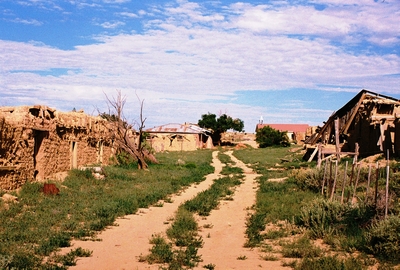
If you’re tooling around the Rio Puerco Valley northwest of Albuquerque, one feature will loom in the distance, possibly beckoning you to come closer (or even climb it), and that’s Cabezon Peak, a volcanic plug left after the erosion of a larger cinder cone. This feature was known as Wasema'a to the Jemez. To the Isletans it was Tchi'kuienad. The Navajo called it Tsenajin, or Black Peak. For them, it represented the head of a giant that had been killed on Mount Taylor, a sacred place, by the Twin Brothers, or War Gods. The lava at the base of the peak then was the giant's blood.
Tsenajin represented the eastern edge of the Navajo's tribal world until the Spanish began to move west of what they, in turn, called El Cabezón, or "The Big Head." The peak is about 2,000 ft. higher than the surrounding landscape and, in 1849, Lt. James Simpson of the U.S. Army traveled through and wrote about "the remarkable peak called Cerro de la Cabeza." It is still remarkable.
Today, just below Cabezon Peak, on the north bank of the Rio Puerco, are the sun-blasted remains of a small village. This is what’s left of Cabezón, New Mexico, settled, it's said, in 1826 by Juan Maestas, who came from Pagosa Springs, Colorado. It was one of four small Hispano agricultural settlements in the area, along with Guadalupe, San Luis, and Casa Salazar. But even before that, going back to the late 1700s, Hispano farmers here had grown corn and chile and harvested wild asparagus along the Rio Puerco.
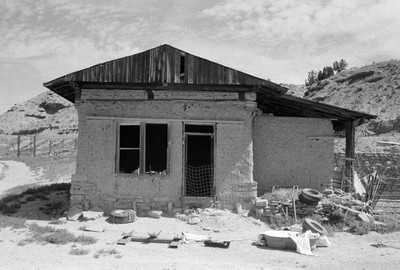
I was told this old adobe was once the Cabezón Bar and Dance Hall. It's hard to imagine now, but if you listen hard you might still hear the clack of boots against the floor.
Before it was Cabezón, the village was known as Rancho de la Posta, or La Posta. “The post” indicated a stage stop, and, indeed, La Posta was on a major stage route west of Santa Fe, and at the crossroads of a trail running between Zuni Pueblo and Jemez Pueblo and a Spanish trail from Albuqueque to Cuba. This confluence of trails makes sense given that Cabezon Peak was and remains an obvious landmark for travelers. However, the area was not permanently occupied until 1872, when the Navajo Reservation was created and skirmishes with settlers ended.
When a post office was applied for in 1879, Rancho de la Posta became Cabezón Station and then just Cabezón. The village thrived for many years, and by 1920 the population may have been as high as 250. There was a church, four stores, several dance halls, the aforementioned post office, some saloons, and dozens of homes. Restie Sandoval, born in Cabezón in 1929 and quoted in Ghost Towns Alive by Linda G. Harris, said, "We had no money, but we were content."
One of the villages’ showpieces was an eleven (or possibly fourteen, depending on who you ask)-room adobe residence occupied by Richard F. Heller and his family, just a few steps across the road from his store. The house also served as hotel, frequently providing lodging to weary travelers. It may yet shelter the occasional bird or rattlesnake, but guests arrive only rarely these days and none stay the night.
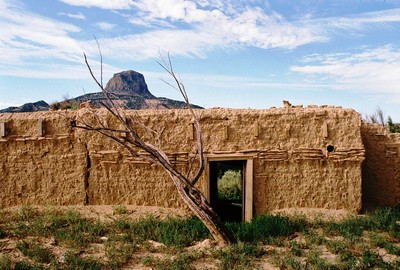
A small section of the Heller family’s 11/14-room adobe home and hotel.
Richard Heller was perhaps Cabezón's most prominent citizen, arriving in 1888 and, with partner John Pflueger, buying the trading post that William Kanzenbach and Rudolph Haberland opened in 1874 and ran until they went deep into debt with their supplier, the Charles Ilfeld Company. Heller helped Cabezón flourish, in part because of trade with the Navajo. Heller and Pflueger were brokers for the wool the Navajo brought in, and some years they would take as many as 40 wagon loads to market in Albuquerque. Heller bought Plueger out in 1894, a deal that perhaps included the 10,000 sheep they owned together, and he remained among the village's leaders until his death, establishing a bit of an empire that would also include 2,000 cattle.
The store ruins that can be seen in Cabezón are not those of the original 1874 trading post, but are of a general store built by Heller in 1910 or 1911 that featured "fancy" turned posts on the front porch and a corrugated tin roof. You can still see the cut-outs in the awning, or “cotes,” for pigeons, which Heller was fond of keeping.
Heller’s family occupied the 11-to-14-room adobe house until shortly after his death in 1947. He'd been living in the village for almost 60 years. By that time, trade with the Navajo had ended and drought had come. For those that raised sheep and cattle, competition for grazing rights after the government purchased the adjacent Ojo del Espíritu Santo Grant in 1934 had driven many out of business. Also, in the early 1940s, four brush-and-stone dams on the Rio Puerco had broken during a flood, and with most men fighting in WWII or working elsewhere, there was no one to repair these dams, which had diverted water into irrigation ditches. Heller's widow kept the post office open for more than a year on her own, but then moved to Albuquerque. So, by 1950, Cabezón was largely vacant and left to begin a slow decline that has continued to this day.
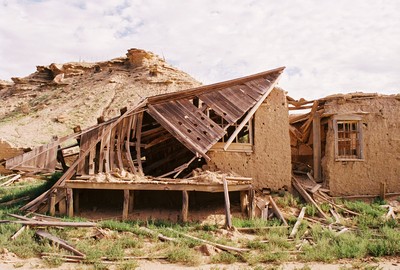
There are many iconic photos of Heller's general store in ghost town books, some shots even taken from the rustic porch. However, the years have not been kind to the building.
Another thing that Heller did was help get a church constructed in Cabezón. La Iglesia de San Jose was built in 1894, and in many ghost town books it appears abandoned and forlorn, as it was for decades. It had been used as a barn and vandals were once caught tearing up the floor in a hunt for treasure. But in the late-1970s, the church began to be restored. I've heard that Peter Fonda bankrolled the work immediately after directing the film The Hired Hand in the village, but that movie, which starred both Fonda and Warren Oates, was released in 1971. So that seems unlikely, to say the least. In any case, you can get a closer view of a much more intact Cabezón in that excellent Western.
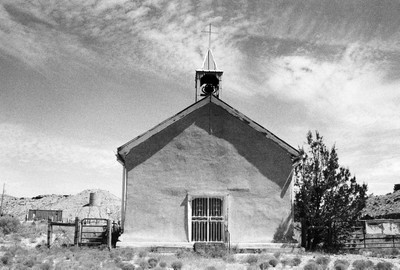
The San Jose Catholic Church was built in 1894.
The real story is that, in 1978, Father John Sauter from up the road in Cuba, New Mexico, wanted to restore the church before its 100th anniversary, which would occur in 1994. So local folks rounded up volunteers to fix the roof, received donated materials, and, over the years, basically did the job with no money at all. Five hundred people attended the centennial celebration. It's worth mentioning that, in addition to the treasure hunters, thieves were once caught trying to steal the church bell. The bell was then put in safe-keeping until it could safely resume its rightful place, which, as you might sorta be able to guess from the photo above, it has.
In his 1981 book, New Mexico's Best Ghost Towns: A Practical Guide, Philip Varney said that Cabezón was, in fact, New Mexico's best ghost town, featuring the most impressive mix of buildings, scenery, and desertion. He also championed Cabezón for the difficulty involved in just getting to the place. Forty-two years later, it’s still difficult to visit (more on that in a moment), and the lanscape is just as scenic. But does Cabezón remain the state’s best ghost town? Well, I'd say…probably not. Of course, Heller's store, the historic centerpiece of Cabezón, has mostly collapsed. A two-story building from The Hired Hand set which, while not historic, did lend ambiance, is totally gone. Most of the adobe homes are badly crumbled and fading fast. Only a few stones stand atop each other of what was the school. The church is actually in better shape than in 1981, but I suppose that just makes Cabezón feel slightly less deserted.
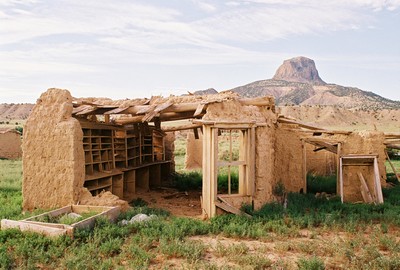
With its many shelves and cubbies, this adobe was probably the post office.
Sure, much of Cabezón's decline is due to neglect and vandalism, but remote ghost towns don't typically have the tax base for neighborhood upkeep, and untended adobes will eventually return to Mother Nature. So I try to get while the getting is good and, as with most things in life, I don't expect permanence in ghost towns. In truth, I was lucky to “get” at all as the property in Cabezón is still owned and the village occupied by one resident who does not exactly desire visitors. In the 1960s, squatters moved into the empty homes and looted them and, as a result, the county comissioner would eventually authorize closing Cabezón. So let’s just say some strings were pulled to open gates, both metaphorical and literal, and make my trip possible. And that was a number of years ago now. Eight years, to be exact.
If you've been to the Cabezón area you might wonder where the timber was found for the buildings. I've read that the vigas were hauled from the forest surrounding Mt. Taylor, a distance of about 10 miles. I guess Mt. Taylor was the closest you could get to a Home Depot at the turn of the 20th century. The stones were gathered from the adjacent hills. I was also told that, much more recently, a woman and her child were in Cabezón and entered a structure when a viga fell, striking the mother and necessitating a trip by helicopter to the hospital. Thus on my visit I was explicitly asked not to enter any buildings. So that is why you see no interiors here.
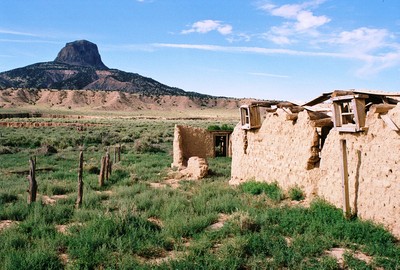
You can almost feel wagons full of wool moving slowly along the Rio Puerco, below Cabezon Peak.
Let’s wrap up our visit to Cabezón with a couple Wild West tales. The Puerco Valley has always been isolated, and so it was that, according to Ralph Looney’s Haunted Highways, in a turn possibly inspired by Jack D. Rittenhouse's rare, Outlaw Days at Cabezon, New Mexico, the village harbored a bandit now and then. In 1884, the Castillo brothers’ notorious band raided the cattle herd of the original owners of the trading post, Kanzenbach and Haberland. A man named Juan Romero tried to stop the rustlers and was shot dead. Kanzenbach organized a posse and a gun battle ensued. The thieves, however, escaped.
After another encounter and escape, the rustlers entered Amadao Lucero's store in Espanola to have dinner. Here the posse was lying in wait. Deputy Montano couldn't get a bead on Candido Castillo's head while the man ate because of a poorly-placed kerosene lamp, so he motioned for Lucero to move the obstacle. A moment later Candido leaned over to light his cigarette with the lamp just as Montano shot, hitting Candido in the side. The Deputy also shot Candido's brother, Manuel, but the two managed to get out the door, somehow melting into the night.
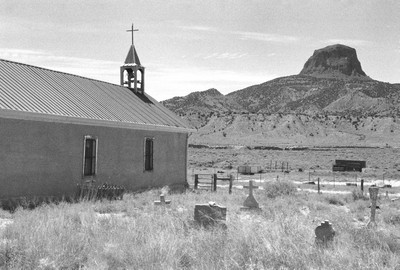
The quiet cemetery of the San Jose Catholic Church.
In the morning, the posse followed the bloodstains, but they ended abruptly at the railroad tracks. The rumor then arose that the brothers, reportedly also members of the Penitente Brotherhood, had happened upon a Good Friday procession and were taken into hiding. Candido was said to be dead by Easter Sunday, but when his grave was opened the body had been removed.
Looney tells of a gruesome ax murder in Cabezón, as well. One day the postal inspector came to town because there was a small discrepancy in cash at the post office, which was run by Emiliano Sandoval. Nobody would say a word to the inspector until he found Juan Valdez at the edge of the village. Valdez said that Sandoval did it. After all, who could've pilfered the money more easily?
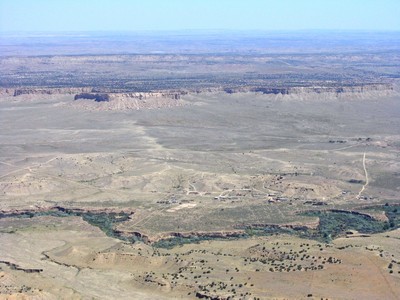
A crow’s eye view of the ghost town of Cabezón from atop Cabezon Peak.
The following night, Valdez was sleeping in his home, his two sons nearby, when several residents of Cabezón entered. When they left it’s said that Valdez had been beheaded. Sandoval County officials quickly arrested Emiliano Sandoval and two others, Albino Gurule and Antonio Gonzalez. Gonzalez, having an alibi, was soon freed. Sandoval and Gurule were kept in custody for a while, but eventually released. The crime was never solved as far as I can tell. Not that it’s uncommon for ghost towns to keep their secrets. On that note, I’m sure Cabezón has more to tell, but this is about all I’ve been able to uncover. If you have more to add, please leave a comment below!
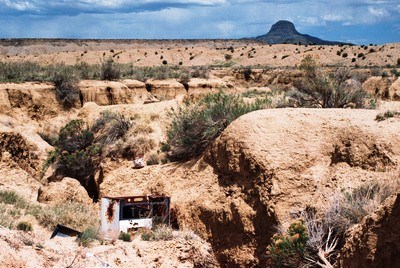
Above is one last look at the landscape of the Rio Puerco drainage with Cabezon Peak looming in the distance. This Puerco, flowing through Rio Arriba, Sandoval, Bernalillo, Valencia, and Socorro Counties before meeting the Rio Grande, is sometimes called the Rio Puerco of the East. Yes, there is another Puerco in New Mexico. The second Puerco, usually called the Puerco River, flows through the northwestern part of the state and into northeastern Arizona, terrain which includes the Painted Desert. That is another spectacular southwestern landscape, but one for another day.
First, thanks to those who got me into Cabezón all those years ago. You know who you are! If you want to know more about life in the Rio Puerco Valley, I can't recommend Nasario García's memoir, Hoe, Heaven, and Hell: My Boyhood in Rural New Mexico highly enough. While Mr. García lived in Ojo del Padre, near Guadalupe, he provides a wonderful picture of the entire region, and Cabezón does get some brief mentions. One of the most recent sources for Cabezón history, and certainly among the best, is Ghost Towns Alive: Trips to New Mexico's Past by Linda G. Harris. But even that is 20 years old now. I also got a lot of the information from Philip Varney's New Mexico's Best Ghost Towns: A Practical Guide and Ralph Looney's Haunted Highways. Surprise, surprise. Both books also have excellent pictures of Cabezón from the days when more was standing. Days that will never come again! I should also mention Robert Julyan's The Place Names of New Mexico, which always has something interesting to offer. I have never seen Route 66 guru Jack D. Rittenhouse's Outlaw Days at Cabezon, New Mexico (limited to 150 copies), nor his more general history, Cabezon: A New Mexico Ghost Town (limited to 750 copies), so if you've got one of either lying around that you'd like to send my way, please do!
That's it! If you made it to the final words of this epic post, thank you very much! I have no idea where we're going next time. I'll have to figure it out.
I met the owner of Cabezon during one of my explorations in the Cabezon area. Also met a rancher out there who offered me a job that I had to refuse as I was in medical school at the time. The native ruins, petroglyphs, and old eroding adobe buildings scattered throughout the area have always fascinated. I’m sure I’ll return again before too long. Thanks for the article and history!
ReplyDeleteNice that the history of those remote settlements will outlive the flimsy buildings.
ReplyDeleteI had the pleasure some time ago of visiting the Guadalupe Pueblo ruins and the remains of the town of Guadalupe with Tom Windes and Nasario Garcia. It is really an interesting area and well worth many visits.
I grew up horseback looking at that peak from the south while working cattle. My dad still ranches there. I didn’t know any of the history associated with it. Thanks for the history lesson. I enjoy the information you put out.
ReplyDeleteHow do you get there? And if it's private property, can we go and take pictures?
ReplyDeleteNo.
DeleteTexmex, as Anonymous said rather succinctly, it's not possible to take pictures of Cabezón as the road is gated above the village itself. I've seen some photos taken from the county road west of Cabezón, but that's a pretty good distance. Also, from what I've encountered recently, vandalism of old buildings seems to be on the rise in New Mexico, and I wouldn't expect Cabezón to welcome visitors anytime soon.
ReplyDeleteHowever, I also wouldn't let the inaccessibility of Cabezón deter you from exploring the Rio Puerco Valley. There is an incredible amount of cool stuff in the area, including the ghost town of Guadalupe. But I should add that after a high-profile killing in Guadalupe in 2020 involving extreme skier Dean Cummings, some of it may no longer be accessible either.
The Gentle Art of Wandering did a wonderful post entitled "A Little Known Fantastic Drive in New Mexico," which covers much of what you *can* see out there. Like I said, it's a lot, and the Rio Puerco Valley is one of my all-time favorite places to explore. After numerous visits I've only scratched the surface.
Anyway, I hope some of this info is useful, even if Cabezón has to be taken off the agenda. JM
Great place! Spent some time wondering around some years ago. The buildings were much more intact. Fun times for sure.
ReplyDeleteMy grandfather, was born there.
ReplyDeleteMy great grandfather was thee Antonio Gonzales. I’d like to know the about time frame for this story. I’ve read stories in regards to his father Ruperto Gonzales.
ReplyDeleteMy grandfather was the original Cordova and settlers there
ReplyDeleteMy grandfather was one of the first original Spanish settlers there the Cordovas
ReplyDelete